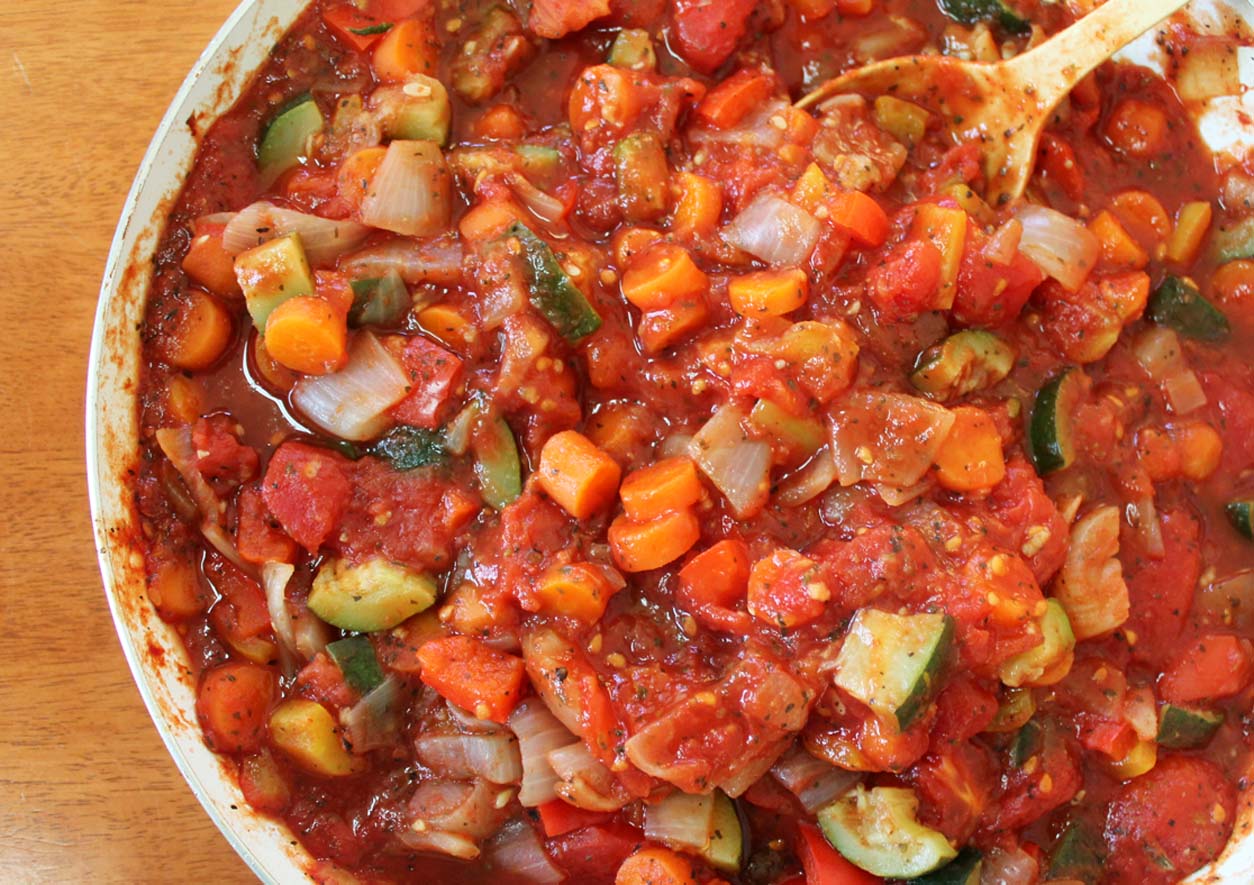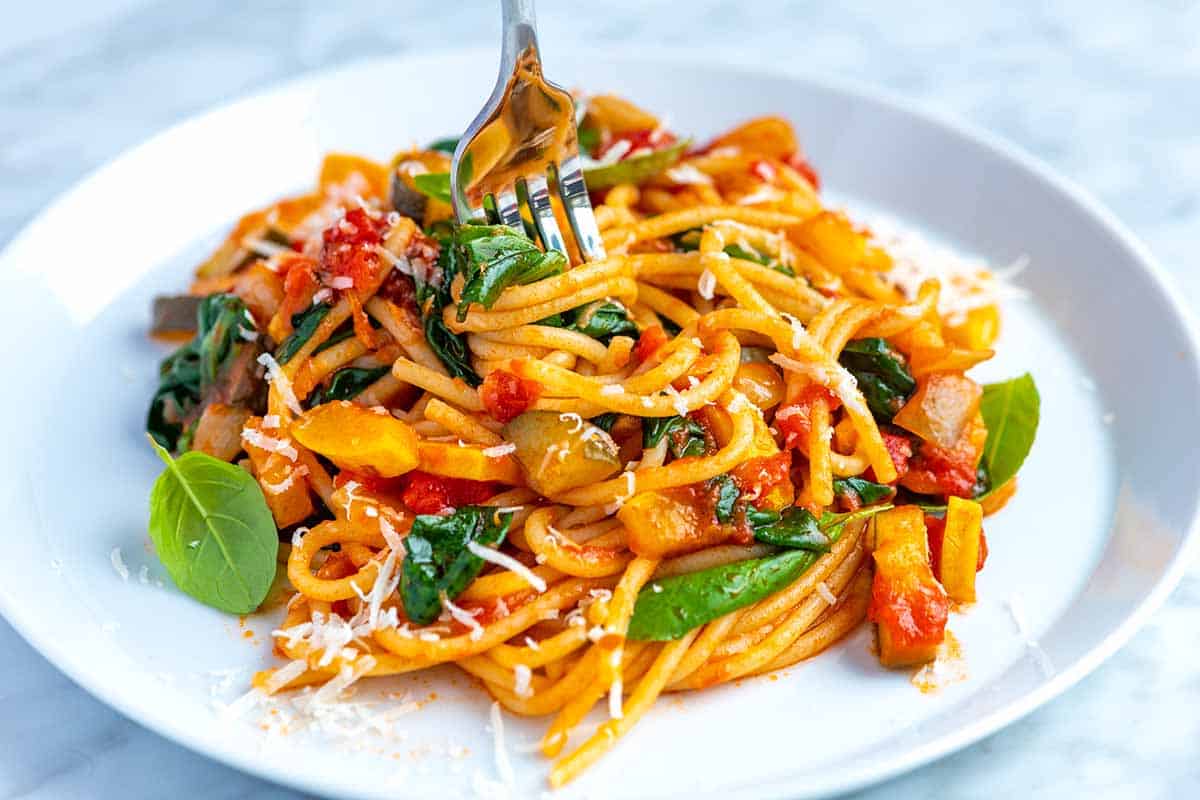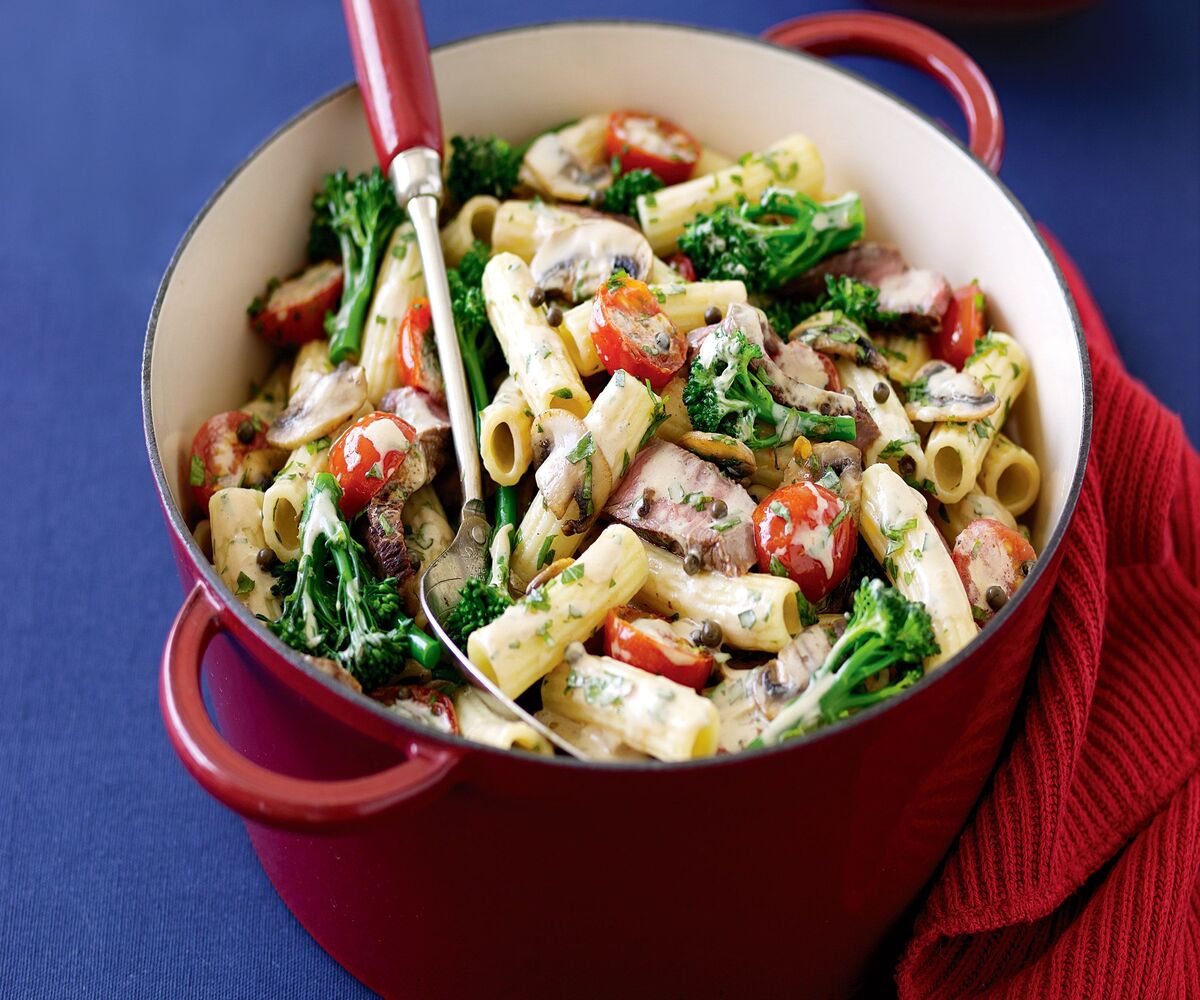Home>Gardening News and Trends>Latest News>What Vegetables Go With Tomato Sauce


Latest News
What Vegetables Go With Tomato Sauce
Published: October 17, 2023
Get the latest news on what vegetables pair perfectly with tomato sauce for a delicious and nutritious meal. Discover new recipes and cooking tips!
(Many of the links in this article redirect to a specific reviewed product. Your purchase of these products through affiliate links helps to generate commission for Chicagolandgardening.com, at no extra cost. Learn more)
Table of Contents
Introduction
When it comes to creating a delicious tomato sauce, it’s not just about the tomatoes. Adding vegetables to your sauce can elevate the flavor and nutritional value, creating a well-rounded and satisfying meal. Whether you’re making a marinara sauce, a bolognese, or a pizza sauce, there are plenty of vegetables that pair perfectly with tomato sauce.
Not only do these vegetables add depth and complexity to your sauce, but they also provide a variety of essential nutrients. From the sweetness of bell peppers to the richness of mushrooms, each vegetable brings a unique flavor profile to complement the tangy and robust taste of tomato sauce.
In this article, we will explore the best vegetables to use in tomato sauce, highlighting their flavors and discussing how they enhance the overall dish. So, if you’re looking to take your tomato sauce to the next level, get ready to discover a world of delicious possibilities.
Note: While this article focuses on vegetables commonly paired with tomato sauce, feel free to experiment with other vegetables based on your personal preferences and dietary restrictions.
Popular Vegetables for Tomato Sauce
When it comes to choosing the right vegetables to enhance your tomato sauce, there are several popular options that can take your dish to a whole new level. These vegetables not only complement the flavors of tomato sauce but also add their own unique textures and nutritional benefits. Let’s take a closer look at some of the top contenders:
- Bell Peppers: Bell peppers, whether red, green, or yellow, add a sweet and slightly tangy flavor to tomato sauce. They also bring a vibrant color and a satisfying crunch. Dice them up and sauté them with onions and garlic for a delicious base.
- Onions: Onions are a staple in many tomato sauce recipes. They add a rich, savory flavor and help create a well-rounded base. Whether you prefer white, yellow, or red onions, they will add depth and complexity to your sauce.
- Garlic: No tomato sauce is complete without garlic. Its aromatic and pungent flavor adds a delicious kick. Sauté minced or crushed garlic in olive oil before adding the tomatoes for a flavorful foundation.
- Zucchini: Zucchini is a versatile vegetable that pairs well with tomato sauce. It adds a mild, slightly sweet flavor and a pleasant texture. Grate or finely chop zucchini and cook it down in the sauce for added depth.
- Eggplant: Eggplant brings a rich and meaty texture to tomato sauce. Once cooked down, it develops a creamy consistency, adding a hearty element to the dish. Dice or slice eggplant and sauté it before incorporating it into your sauce.
- Mushrooms: Whether you choose button mushrooms, cremini, or shiitake, mushrooms add an earthy and umami flavor to tomato sauce. Sauté them with onions and garlic to enhance their natural richness.
- Carrots: Carrots are often used to balance the acidity of tomato sauce and add a subtle sweetness. Finely grate or puree the carrots before adding them to the sauce, allowing them to blend seamlessly.
- Spinach: Spinach is a nutritious addition to tomato sauce, providing an extra dose of vitamins and minerals. It wilts down quickly and adds a vibrant green color to your sauce. Stir in fresh or frozen spinach just before serving.
- Kale: Kale is a nutrient powerhouse that can be incorporated into tomato sauce. Its slightly bitter taste pairs well with the sweetness of tomatoes. Remove the stems and roughly chop the leaves before adding them to the sauce.
- Celery: Celery brings a subtle and refreshing flavor to tomato sauce. It adds a pleasant crunch and complements the other vegetables in the sauce. Chop the celery finely and sauté it with the onions and garlic.
- Olives: While technically a fruit, olives can add a savory and briny note to tomato sauce. They provide a unique flavor profile and are especially delicious in Mediterranean-inspired dishes. Chop them up and stir them into the sauce.
These are just a few examples of the popular vegetables that pair well with tomato sauce. Don’t be afraid to experiment and combine different vegetables to create your own unique flavor profiles. Whether you prefer a chunky or smooth sauce, these vegetables will add depth, texture, and vibrant flavors to your tomato-based dishes. So, get creative in the kitchen and enjoy the endless possibilities!
Bell Peppers
Bell peppers are a colorful and versatile vegetable that pairs exceptionally well with tomato sauce. They bring a touch of sweetness and a mildly tangy flavor, enhancing the overall taste of the sauce. Whether you choose the red, green, or yellow variety, bell peppers add both flavor and visual appeal to your dish.
When preparing bell peppers for tomato sauce, start by removing the stem and seeds, then slice or dice the pepper according to your preference. The peppers can be sautéed along with onions and garlic, or added directly to the sauce for simmering.
Red bell peppers, in particular, are known for their sweetness and are a popular choice for tomato sauce. Their vibrant color and mellow flavor provide a delightful contrast to the tanginess of the tomatoes. Green bell peppers have a slightly bitter flavor and offer a crunchier texture, while the yellow variety adds a mild sweetness to the sauce.
Bell peppers are also rich in vitamins A and C, providing additional nutritional value to your tomato sauce. They contain antioxidants that help boost immunity and promote overall well-being. A great way to incorporate more bell peppers into your diet is by adding them to your tomato sauce.
Furthermore, bell peppers lend themselves well to different types of tomato dishes. For example, if you’re making a chunky marinara sauce, diced bell peppers can provide texture and flavor. On the other hand, if you prefer a smoother sauce, you can puree the bell peppers and mix them with the tomatoes for a harmonious blend.
In addition to their taste and nutritional benefits, bell peppers bring visual appeal to your tomato sauce. The bright colors of the peppers create an appetizing presentation, making the dish visually appealing and enticing.
Overall, bell peppers are an excellent choice for enhancing the flavor, texture, and nutritional value of your tomato sauce. Whether you prefer them diced, sliced, or pureed, they will add a touch of sweetness and a burst of color to your dish. So, next time you’re making tomato sauce, don’t forget to include bell peppers for a delicious and well-rounded culinary experience.
Onions
Onions are a fundamental ingredient in many tomato sauce recipes, adding a savory and aromatic flavor that enhances the overall taste profile. They are incredibly versatile and can be used in various forms, such as diced, sliced, or minced, depending on your preference.
When cooking with onions for tomato sauce, it is common to start by sautéing them in olive oil or butter until they become translucent and slightly caramelized. This process helps release their natural sweetness and develops a rich flavor that complements the tanginess of the tomatoes.
Onions bring a depth and complexity to tomato sauce, acting as a flavor base for the other ingredients. They create a harmonious balance of sweetness and savory notes, making the sauce more well-rounded and satisfying. Whether you choose white, yellow, or red onions, each variety adds its unique flavor profile to the sauce.
White onions have a milder and sweeter taste, while yellow onions offer a stronger and more pungent flavor. Red onions, on the other hand, provide a slightly spicier and tangier element, which can be a great addition to certain types of tomato sauces. You can experiment with different onion varieties to find the one that suits your taste preferences.
In addition to their flavor contribution, onions are a nutritional powerhouse. They are rich in antioxidants and contain vitamins C and B6, which help support a healthy immune system and maintain overall well-being. Incorporating onions into your tomato sauce not only enhances the taste but also adds a nutritional boost to your meal.
Moreover, onions add texture to the sauce, providing a pleasant crunch when they are not fully cooked down. However, if you prefer a smoother sauce, you can finely chop or puree the onions for a more blended consistency.
Whether you’re making a classic marinara sauce, a hearty bolognese, or a flavorful pizza sauce, onions are an essential ingredient that brings depth, flavor, and texture to your tomato sauce. Their versatility and nutritional benefits make them a fantastic addition to any recipe. So, don’t underestimate the power of onions when creating your next batch of tomato sauce.
Garlic
Garlic is a staple ingredient in tomato sauce, adding a distinctive and robust flavor that elevates the overall taste profile. Its pungent aroma and depth of flavor make it a key component in many beloved recipes.
When using garlic in tomato sauce, it is essential to start by mincing or crushing the cloves to release their flavorful oils. One popular method is to sauté the garlic in olive oil before adding the tomatoes, as this enhances its flavor and creates a fragrant base for the sauce.
Garlic brings a unique tanginess and earthiness to tomato sauce, enhancing its complexity. It complements the natural acidity of the tomatoes, balancing the sweetness and adding depth to the overall taste. The intensity of garlic can be adjusted to personal preference, allowing you to control the level of flavor in your sauce.
Besides its distinctive taste, garlic also offers numerous health benefits. It contains compounds with potential antioxidant and immune-boosting properties, making it a valuable addition to your diet. Garlic is also believed to have anti-inflammatory properties and may help support heart health.
In terms of texture, garlic adds a satisfying crunch when lightly cooked. However, if you prefer a milder and smoother garlic flavor, you can finely mince or even puree the garlic, ensuring it blends seamlessly into the sauce.
Garlic pairs well with various other vegetables and ingredients commonly used in tomato sauce, such as onions, bell peppers, and herbs like basil and oregano. The combination of these flavors creates a harmonious and well-balanced sauce that is both fragrant and delicious.
Whether you’re making a simple tomato marinara, a rich bolognese, or a garlic-infused pizza sauce, garlic is a crucial ingredient that brings depth and character to your dish. Its versatility and strong flavor profile make it a popular choice among cooks and food enthusiasts alike.
So, the next time you’re preparing your tomato sauce, be sure to include garlic to enhance its taste and aroma. With just a few cloves of this aromatic bulb, you can transform your sauce into a flavorful and memorable culinary experience.
Zucchini
Zucchini is a versatile vegetable that can add a hint of sweetness and a pleasant texture to tomato sauce. Its mild flavor makes it a great complement to the tanginess of the tomatoes, enhancing the overall taste profile of the sauce.
When incorporating zucchini into your tomato sauce, you have a few options. You can grate or finely chop the zucchini and add it directly to the sauce, allowing it to cook down and blend with the other ingredients. Alternatively, you can sauté the zucchini in olive oil before adding it to the sauce for a slightly firmer texture.
Zucchini not only adds depth and flavor to your tomato sauce but also brings a nutritional boost. It is low in calories and high in fiber, vitamins, and minerals. The presence of zucchini in your sauce will increase its nutritional value, making it a healthier choice for your meals.
The texture of zucchini is another reason to consider using it in tomato sauce. When cooked, it becomes tender yet slightly firm, providing a pleasant bite that adds interest to the dish. This makes zucchini an excellent option for those who enjoy a chunkier tomato sauce.
In addition to its flavor and texture, zucchini is a versatile vegetable that pairs well with a variety of other ingredients. It can be combined with onions, garlic, and bell peppers to create a flavorful base for the sauce. Zucchini also carries the added benefit of helping to lighten the dish and add a vibrant touch of green.
Whether you’re preparing a classic tomato marinara, a vegetable-packed pasta sauce, or a summer-inspired ratatouille, zucchini can be a valuable addition to your recipe. Its subtle sweetness and appealing texture make it a versatile ingredient that enhances the overall taste and appearance of your tomato sauce.
So, the next time you’re looking to add some variety to your tomato sauce, don’t hesitate to include zucchini. It can bring a delightful twist and a touch of freshness, making your sauce even more enjoyable and nutritious.
Eggplant
Eggplant, also known as aubergine, is a versatile vegetable that can add a rich and meaty texture to tomato sauce. Its silky consistency and ability to absorb flavors make it an excellent addition to enhance the overall taste and mouthfeel of the sauce.
When incorporating eggplant into your tomato sauce, it is common to start by peeling the skin and then dicing or slicing it into bite-sized pieces. This allows the eggplant to cook evenly and absorb the flavors of the sauce.
Eggplant brings a unique flavor to tomato sauce, with nuance and depth that is different from other vegetables. Once cooked down, it develops a creamy consistency and blends seamlessly with the sauce, creating a hearty and satisfying dish.
In addition to its taste, eggplant is also packed with nutrients. It is a good source of dietary fiber and contains vitamins C and K. Incorporating eggplant into your tomato sauce not only adds a delicious flavor but also contributes to a healthier and balanced meal.
One of the advantages of using eggplant in tomato sauce is its ability to add richness without overwhelming the overall flavor. Its subtle earthiness enhances the natural sweetness of the tomatoes, creating a well-balanced and complex taste profile.
Eggplant can be used in various types of tomato sauces, from a classic marinara to a hearty bolognese. It pairs well with other ingredients commonly found in tomato sauces, such as onions, garlic, and herbs like basil and oregano.
Whether you roast, sauté, or simmer the eggplant, it will absorb the flavors of the sauce and contribute to the overall depth and richness of the dish. It is also an excellent ingredient for those seeking a vegetarian or vegan alternative to meat-based sauces, as it provides a similar texture and heartiness.
Next time you’re looking to add a meaty texture and a touch of richness to your tomato sauce, consider incorporating eggplant. Its versatility, nutrient content, and ability to blend seamlessly with the flavors of the sauce make it an excellent choice for elevating your culinary creations.
Mushrooms
Mushrooms are a fantastic addition to tomato sauce, offering an earthy and savory flavor that pairs beautifully with the tanginess of the tomatoes. Whether you choose common button mushrooms, flavorful cremini, or exotic shiitake mushrooms, they will add depth and richness to your sauce.
When incorporating mushrooms into your tomato sauce, start by cleaning them with a damp cloth or soft brush to remove any dirt. You can then slice or chop them according to your desired texture. Mushrooms can be sautéed in olive oil or butter until they become golden brown and slightly caramelized before adding them to the sauce.
Mushrooms are known for their umami flavor, which adds a delightful savoriness to the tomato sauce. This flavor profile enhances the overall taste, creating a more complex and satisfying dish. Mushrooms also contribute a meaty texture, making them a great addition for those seeking a vegetarian or vegan alternative to meat-based sauces.
In addition to their rich flavor, mushrooms are low in calories and offer various nutritional benefits. They are a good source of vitamins, minerals, and antioxidants that can support overall health. By incorporating mushrooms into your tomato sauce, you are not only enhancing its taste but also adding a nutritious component to your meal.
Mushrooms pair well with other ingredients commonly used in tomato sauce, such as onions and garlic. Together, they create a flavorful base that forms the foundation of the sauce. You can also experiment with different mushroom varieties to add depth and complexity to your dish.
Whether you’re preparing a classic marinara, a creamy mushroom tomato sauce, or a hearty mushroom bolognese, adding mushrooms will bring a delightful depth and richness to your tomato-based dishes. Their savory flavor and meaty texture make them a popular choice among mushroom lovers and tomato sauce enthusiasts alike.
So, don’t be afraid to get creative and incorporate mushrooms into your next batch of tomato sauce. The combination of their earthy taste, nutritional benefits, and textural appeal will take your sauce to new heights of flavor and enjoyment.
Carrots
Carrots may not be the first vegetable that comes to mind when thinking about tomato sauce, but they can be a delightful addition that brings a natural sweetness and balance to the sauce. Adding carrots to your tomato sauce can help counteract the acidity of the tomatoes and create a harmonious flavor profile.
When using carrots in tomato sauce, peel and finely grate them or puree them for a smoother texture. By doing so, the carrots will blend seamlessly into the sauce, infusing it with their subtle sweetness and enhancing its nutritional content.
Carrots are not only tasty but also packed with essential nutrients. They are rich in vitamin A, antioxidants, and dietary fiber, making them a healthy addition to your sauce. Their vibrant orange color also adds visual appeal to the dish, making it more inviting and appealing.
The natural sweetness of carrots can help balance the acidity of the tomatoes and add depth to the sauce’s flavor. The result is a well-rounded and satisfying sauce that pleases both the palate and the senses. Carrots work particularly well in tomato-based soups, stews, and simmered dishes.
In addition to their flavor, carrots also contribute to the texture of the sauce. When cooked, they become tender and add a subtle crunch, adding interest and variety to the overall mouthfeel.
Carrots can be easily combined with other vegetables, such as onions, celery, and bell peppers, which are commonly used in tomato sauce recipes. Their versatility and mild taste make them a versatile ingredient that can enhance the flavors of various dishes.
So, if you’re looking to add a touch of sweetness and balance to your tomato sauce, consider adding carrots. They offer a natural sweetness, nutritional benefits, and an attractive color that elevate the flavor and appearance of your dish.
Spinach
Spinach is a nutrient-packed leafy green that can be a wonderful addition to tomato sauce. Its vibrant color, delicate flavor, and nutritional benefits make it an excellent choice for enhancing the taste and nutritional value of your dish.
When incorporating spinach into your tomato sauce, you have two main options. You can add fresh spinach leaves directly to the sauce, allowing them to wilt down and blend with the other ingredients. Alternatively, you can sauté the spinach beforehand to soften it and release its flavors.
Spinach adds a refreshing and subtle savory taste to tomato sauce, creating a delightful contrast to the tanginess of the tomatoes. Its tender leaves complement the texture of the sauce and provide a burst of vibrant green, making your dish visually appealing.
In addition to its flavor and visual appeal, spinach offers an array of nutritional benefits. It is loaded with vitamins A, C, and K, as well as iron, calcium, and fiber. By incorporating spinach into your tomato sauce, you are boosting its nutritional content and promoting overall health and well-being.
Spinach also works well with other ingredients typically found in tomato sauce recipes. Whether it’s combined with onions, garlic, or other vegetables, the flavors of spinach blend harmoniously with the overall profile, enhancing the taste of the sauce.
Spinach can be used in various tomato-based dishes, from classic marinara sauces to lasagnas and pasta bakes. Its versatility allows it to be incorporated into both vegetarian and meat-based recipes, adding a vibrant touch and a nutritional boost.
So, if you’re looking to add an extra punch of nutrients and a burst of color to your tomato sauce, consider adding spinach. Its delicate flavor, nutritional content, and appealing appearance make it a fantastic choice for creating a well-rounded and tasty sauce.
Kale
Kale, a nutrient powerhouse among leafy greens, can be a fantastic addition to tomato sauce, providing a burst of vitamins and a robust flavor. Known for its dark green and frilly leaves, kale brings a unique taste and texture to your sauce.
When using kale in tomato sauce, remove the tough center stems and chop or tear the leaves into smaller pieces. This helps them cook down evenly and blend well with the other ingredients. You can add the kale directly to the simmering sauce or sauté it beforehand to soften its texture.
One of the key benefits of kale is its impressive nutritional content. It is loaded with vitamins A, C, and K, as well as fiber, calcium, and iron. By incorporating kale into your tomato sauce, you are boosting its nutrient profile and promoting overall health.
Kale has a slightly bitter and earthy flavor that adds depth and complexity to the sauce. When cooked, its leaves become tender but still retain a pleasant bite, contributing to the texture of the sauce. This makes kale a great choice for those seeking a hearty and nutritious tomato sauce.
In addition to its taste, kale is a versatile vegetable that works well with other ingredients commonly used in tomato sauce, such as onions, garlic, and herbs like basil and oregano. Its robust flavor holds up well with rich tomato flavors and adds an extra layer of complexity to the sauce.
While kale may be more commonly associated with salads and smoothies, incorporating it into tomato sauce is a creative and delicious way to enjoy its benefits. It brings a vibrancy and nutritional boost to your sauce, making it a wholesome and flavorful addition to your meals.
So, if you’re looking to amp up the nutrients and flavor of your tomato sauce, consider adding some kale. Its dark, leafy goodness will not only satisfy your taste buds but also fuel your body with the vitamins and minerals it needs.
Celery
Celery may be commonly associated with soups and salads, but it can also be a wonderful addition to tomato sauce. With its crisp texture and subtle flavor, celery brings a refreshing and mildly savory element to the sauce.
When incorporating celery into your tomato sauce, it is best to chop it finely to ensure it cooks evenly and integrates well with the other ingredients. Sautéing the celery with onions and garlic at the start of the sauce-making process helps build a flavorful base.
Celery contributes a pleasant crunch and subtle herbal taste to the sauce. Its mild flavor complements the acidity of the tomatoes and adds depth to the overall profile, making the sauce more well-rounded and satisfying. It can help balance the flavors and enhance the overall taste experience.
In addition to its flavor, celery is known for its hydrating properties and low-calorie content. It is also a good source of dietary fiber, vitamin K, and antioxidants. Including celery in your tomato sauce not only adds a refreshing crunch but also contributes to a healthier and more nutritious meal.
Furthermore, celery pairs well with other vegetables commonly used in tomato sauce, such as onions, bell peppers, and carrots. It blends seamlessly with these ingredients, creating a harmonious flavor combination and enhancing the overall taste of the sauce.
Celery is a versatile ingredient that can be used in various tomato-based dishes, from classic marinara and pasta sauces to soups and stews. Its ability to impart a subtle herbal taste and a delightful crunch makes it a versatile and valuable addition to your culinary repertoire.
So, if you’re looking for a refreshing and mildly savory component to enhance your tomato sauce, don’t overlook the addition of celery. Its texture, flavor, and nutritional benefits make it a fantastic choice to elevate the taste and overall enjoyment of your sauce.
Olives
Olives, while technically a fruit, can add a unique and savory note to tomato sauce. Their briny and tangy flavor profile can elevate the taste of the sauce, bringing a delightful Mediterranean twist.
When incorporating olives into tomato sauce, consider using pitted olives for convenience. You can chop them finely or leave them whole, depending on the texture you desire. Olives can be added directly to the sauce for simmering or stirred in towards the end of cooking for a more pronounced flavor.
The addition of olives introduces a bold and distinctive taste to the tomato sauce. Their brininess adds depth and complexity, balancing the acidity of the tomatoes. Olives also contribute a savory note that pairs well with other ingredients like garlic, onions, and herbs commonly used in tomato sauce recipes.
While black and green olives are typically used in tomato sauce, there is a wide variety of olive types available, each with its own flavor profile. For example, Kalamata olives have a rich and robust flavor, whereas green olives offer a milder and slightly bitter taste. Feel free to experiment with different types of olives to find the perfect match for your sauce.
In addition to their unique flavor, olives are a good source of healthy fats, vitamin E, and antioxidants. They can add a nutritional boost to your tomato sauce, offering potential health benefits along with the satisfying taste.
Olives work well in various tomato-based dishes, such as pasta sauces, pizzas, and Mediterranean-inspired recipes. Their flavor complements the ingredients commonly found in these dishes, creating a harmonious combination that will transport your taste buds to the sunny shores of the Mediterranean.
So, if you’re seeking to infuse your tomato sauce with a tangy and briny twist, consider adding olives. Their unique flavor and nutritional benefits make them a standout ingredient that will enhance the taste and overall appeal of your sauce.
Conclusion
Incorporating vegetables into tomato sauce is a fantastic way to add depth, flavor, and nutritional value to your dishes. From the sweet crunch of bell peppers to the earthy richness of mushrooms, each vegetable brings its own unique contribution to the sauce.
By selecting a variety of vegetables, you can create a well-rounded and satisfying tomato sauce that is bursting with flavors. Bell peppers, onions, garlic, zucchini, eggplant, mushrooms, carrots, spinach, kale, celery, and olives are all excellent choices that complement and enhance the tanginess of the tomatoes.
Beyond their taste, vegetables also pack a nutritional punch. They provide essential vitamins, minerals, antioxidants, and dietary fiber, making your tomato sauce not only delicious but also a wholesome and nutritious addition to your meals.
Adding vegetables to tomato sauce allows for creativity and experimentation in the kitchen. You can mix and match different vegetables to create personalized flavor profiles that suit your preferences. Whether you prefer a chunky sauce with distinct vegetable pieces or a smooth blend where the vegetables meld into the background, the possibilities are endless.
So the next time you’re preparing tomato sauce, don’t forget to incorporate some of these popular vegetables. Their flavors, textures, and nutritional benefits will take your sauce to new heights, transforming it into a vibrant and nourishing culinary delight.










